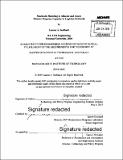| dc.contributor.advisor | Jarrod Goentzel. | en_US |
| dc.contributor.author | Seelbach, Lauren A | en_US |
| dc.contributor.other | Massachusetts Institute of Technology. Technology and Policy Program. | en_US |
| dc.coverage.spatial | n-us--- n-us-fl | en_US |
| dc.date.accessioned | 2015-09-17T19:02:40Z | |
| dc.date.available | 2015-09-17T19:02:40Z | |
| dc.date.copyright | 2015 | en_US |
| dc.date.issued | 2015 | en_US |
| dc.identifier.uri | http://hdl.handle.net/1721.1/98656 | |
| dc.description | Thesis: S.M. in Technology and Policy, Massachusetts Institute of Technology, Engineering Systems Division, Technology and Policy Program, 2015. | en_US |
| dc.description | Cataloged from PDF version of thesis. | en_US |
| dc.description | Includes bibliographical references (pages 113-118). | en_US |
| dc.description.abstract | When a disaster occurs in the United States, individuals in the impacted areas look to the local, state and federal government agencies to provide aid in the form of food, water, shelter, and other essential commodities. The responding agencies have the task of preparing their logistics networks in advance of a disaster to enable them to meet the demand for these essential commodities shortly after an event occurs. This thesis uses stochastic modeling and related metrics to answer three central questions that inform the development of a framework for applying these metrics for evaluating the disaster response capacity of a logistics network. The thesis answers the questions of (1) where should inventory be placed, considering both normal, steady-state allocation of inventory as well as allocation of inventory in advance of a notice event such as a hurricane, (2) how does private sector involvement change the response capacity of a logistics network, and (3) what is the impact of reduced demand for critical commodities on the logistics network's ability to respond? Two case studies are conducted on the logistics networks of the Federal Emergency Management Agency (FEMA) and the Florida Division of Emergency Management (FDEM). Results from these case studies indicate that applying stochastic modeling and the associated metrics to inform the allocation of critical commodities in a logistics network demonstrate measurable benefits in terms of fraction of overall demand met, time to serve a disaster affected population, and related metrics. For prepositioning decisions in FDEM's logistics network the benefits were particularly convincing. By locating stock closer to the areas predicted to suffer the greatest losses, FDEM is able to decrease the time per unit served of two critical commodities by 10-15%. For FEMA's logistics network, results indicate that restructuring the terms of contract stock has the potential to increase fraction of overall demand served by 14% within 24 hours after a disaster and 16% within 36 hours after a disaster. | en_US |
| dc.description.statementofresponsibility | by Lauren A. Seelbach. | en_US |
| dc.format.extent | 118 pages | en_US |
| dc.language.iso | eng | en_US |
| dc.publisher | Massachusetts Institute of Technology | en_US |
| dc.rights | M.I.T. theses are protected by copyright. They may be viewed from this source for any purpose, but reproduction or distribution in any format is prohibited without written permission. See provided URL for inquiries about permission. | en_US |
| dc.rights.uri | http://dspace.mit.edu/handle/1721.1/7582 | en_US |
| dc.subject | Engineering Systems Division. | en_US |
| dc.subject | Technology and Policy Program. | en_US |
| dc.title | Stochastic modeling to allocate and assess disaster response capacity in logistics networks | en_US |
| dc.type | Thesis | en_US |
| dc.description.degree | S.M. in Technology and Policy | en_US |
| dc.contributor.department | Massachusetts Institute of Technology. Engineering Systems Division | |
| dc.contributor.department | Technology and Policy Program | |
| dc.identifier.oclc | 920678383 | en_US |
